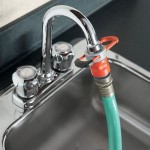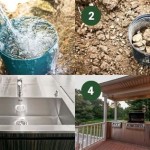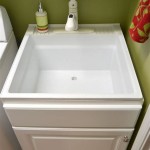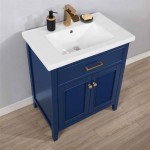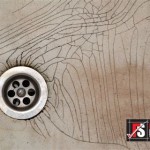Here's an article about bathroom vanities with sinks and faucets, adhering to your specifications:
Bathroom Vanities With Sinks And Faucets: A Comprehensive Guide
The bathroom vanity, often serving as the focal point of a bathroom, has evolved beyond a simple storage solution. Modern bathroom vanities with sinks and faucets offer a seamless blend of functionality and aesthetics, providing a coordinated design element that can significantly enhance the overall look and feel of the space. The selection process involves considering various factors, including size, style, material, and the inclusion of pre-installed sinks and faucets. Understanding these different aspects is crucial for making an informed decision that aligns with the specific needs and design preferences of the homeowner.
The decision to purchase a bathroom vanity with a pre-installed sink and faucet setup can simplify the renovation or construction process. Rather than sourcing each component individually, these all-in-one units offer a cohesive and often more cost-effective solution. However, it's essential to carefully evaluate the quality and style of the sink and faucet included to ensure they meet the required standards and aesthetic expectations. This comprehensive guide aims to provide a detailed overview of bathroom vanities with sinks and faucets, covering various types, materials, installation considerations, and maintenance tips.
Key Considerations When Choosing a Bathroom Vanity With Sink and Faucet
Selecting the appropriate bathroom vanity with a sink and faucet requires careful consideration of several key factors. These factors encompass the physical dimensions of the bathroom, the desired style and aesthetic, the functionality needed, and the budget allocated for the project. Overlooking any of these elements can lead to dissatisfaction and potential complications during installation or long-term use.
Space and Dimensions: The available space in the bathroom is a primary constraint. Measuring the area precisely is critical to ensure the vanity fits comfortably without obstructing movement. Consider the placement of doors, windows, and other fixtures when determining the optimal size and configuration of the vanity. Smaller bathrooms may benefit from wall-mounted or corner vanities to maximize floor space. Larger bathrooms can accommodate double vanities, providing ample counter space and storage for multiple users.
Style and Aesthetics: Bathroom vanities come in a wide range of styles, from traditional and classic to modern and contemporary. The chosen style should complement the overall design of the bathroom and reflect the homeowner's personal taste. Traditional vanities often feature ornate details, raised panel doors, and antique finishes. Modern vanities typically have clean lines, minimalist designs, and sleek hardware. Transitional styles bridge the gap between traditional and modern, offering a balanced aesthetic. The sink and faucet should also align with the chosen style; for example, a vessel sink with a waterfall faucet would suit a modern vanity, while an undermount sink with a widespread faucet would complement a traditional design.
Functionality and Storage: The primary purpose of a bathroom vanity is to provide storage for toiletries, towels, and other bathroom essentials. Consider the amount of storage space required based on the number of users and the items to be stored. Vanities with drawers, cabinets, and open shelving offer different storage options. Drawers are ideal for organizing smaller items, while cabinets can accommodate larger items such as towels and cleaning supplies. Open shelving provides easy access to frequently used items and can be used for decorative displays.
Types of Bathroom Vanities With Sinks and Faucets
Bathroom vanities are available in a variety of configurations, each offering unique advantages in terms of space utilization, style, and functionality. Understanding the different types of vanities is essential for selecting the one that best suits the specific requirements of the bathroom.
Freestanding Vanities: Freestanding vanities are the most common type, offering a wide range of styles and sizes. They stand independently on the floor and are relatively easy to install. Freestanding vanities typically provide ample storage space and can be easily moved if necessary. They are suitable for bathrooms of all sizes and styles.
Wall-Mounted Vanities: Wall-mounted vanities, also known as floating vanities, are mounted directly to the wall, creating a sense of spaciousness in the bathroom. They eliminate the need for legs, making it easier to clean the floor underneath. Wall-mounted vanities are particularly well-suited for smaller bathrooms, as they maximize floor space. They offer a modern and minimalist aesthetic.
Corner Vanities: Corner vanities are designed to fit snugly into the corner of a bathroom, making them an excellent choice for maximizing space in small or awkwardly shaped bathrooms. They typically have a triangular or L-shaped design and offer limited storage space. Corner vanities are available in a variety of styles and finishes.
Double Vanities: Double vanities feature two sinks and faucets, providing ample space for two users to use the bathroom simultaneously. They are ideal for master bathrooms or bathrooms shared by multiple individuals. Double vanities typically offer abundant counter space and storage space. They require a larger bathroom to accommodate their size.
Materials and Construction
The materials used in the construction of a bathroom vanity significantly impact its durability, appearance, and maintenance requirements. Choosing the right materials is crucial for ensuring the longevity and aesthetic appeal of the vanity.
Wood: Solid wood is a classic choice for bathroom vanities, offering a warm and natural aesthetic. It is durable and can be easily refinished or repainted. However, solid wood is susceptible to moisture damage and requires proper sealing and maintenance. Popular wood species for bathroom vanities include oak, maple, cherry, and walnut.
Plywood: Plywood is an engineered wood product made from multiple layers of wood veneer glued together. It is more resistant to moisture damage than solid wood and is less likely to warp or crack. Plywood is a cost-effective option for bathroom vanities and can be finished with a variety of veneers or laminates.
MDF (Medium-Density Fiberboard): MDF is another engineered wood product made from wood fibers bonded together with resin. It is smooth, consistent, and easy to paint or laminate. MDF is less expensive than solid wood and plywood but is more susceptible to moisture damage. It is suitable for bathroom vanities in well-ventilated bathrooms.
Laminate: Laminate is a synthetic material made from layers of paper or fabric impregnated with resin. It is durable, water-resistant, and easy to clean. Laminate is available in a wide range of colors, patterns, and textures, making it a versatile option for bathroom vanities. Laminate vanities are typically more affordable than solid wood or plywood vanities.
Quartz and Granite: For countertops, quartz and granite are popular choices. They are durable, heat-resistant, and scratch-resistant, making them ideal for bathroom environments. Quartz is an engineered stone product, providing a consistent color and pattern. Granite is a natural stone, offering unique variations in color and veining. Both quartz and granite require sealing to prevent staining.
Sinks: Sink materials include ceramic, porcelain, glass, stone, and stainless steel. Ceramic and porcelain are common choices due to their durability and ease of cleaning. Glass sinks offer a modern aesthetic, while stone sinks provide a natural and rustic look. Stainless steel sinks are durable and hygienic.
Faucets: Faucets are typically made from brass, stainless steel, or chrome. Brass is a durable and corrosion-resistant material but can be more expensive. Stainless steel is a cost-effective alternative that is also resistant to corrosion. Chrome is a popular finish for faucets, offering a sleek and modern look.
Installation and Maintenance
Proper installation and regular maintenance are essential for ensuring the longevity and functionality of a bathroom vanity with a sink and faucet. Incorrect installation can lead to leaks, damage, and structural issues. Regular maintenance helps prevent problems and keeps the vanity looking its best.
Installation: Installation of a bathroom vanity typically involves connecting the water supply lines and drainpipe to the sink and faucet. It is crucial to shut off the water supply before starting the installation process. Follow the manufacturer's instructions carefully to ensure proper installation. If unsure, it is recommended to hire a professional plumber or contractor to install the vanity.
Cleaning: Regular cleaning is essential for maintaining the appearance of the bathroom vanity. Wipe down the vanity surface regularly with a damp cloth to remove dust, dirt, and spills. Use a mild cleaner to remove stubborn stains. Avoid using abrasive cleaners or scouring pads, as they can scratch the surface. Clean the sink and faucet regularly with a suitable cleaner to prevent buildup of soap scum and hard water deposits.
Maintenance: Inspect the vanity regularly for signs of leaks, damage, or wear. Tighten loose screws or bolts. Repair any cracks or chips in the vanity surface. Replace worn-out hardware. Seal the countertop regularly to prevent staining. Check the drainpipe for clogs and clear them as needed. Replace faucet washers or cartridges if the faucet is dripping.
Cost Considerations
The cost of a bathroom vanity with a sink and faucet can vary widely depending on several factors, including the size, style, materials, and brand. It is important to establish a budget before starting the selection process to avoid overspending.
Budget Vanities: Budget vanities are typically made from less expensive materials such as laminate or MDF and feature simple designs. They are a cost-effective option for homeowners on a tight budget. Expect to pay anywhere from $200 to $500 for a basic vanity with a sink and faucet included.
Mid-Range Vanities: Mid-range vanities offer a balance of quality and affordability. They are typically made from plywood or solid wood and feature more detailed designs. They come with a wider range of sink and faucet options. They can range from $500 to $1500.
High-End Vanities: High-end vanities are made from premium materials such as solid wood, quartz, or granite and feature elaborate designs. They come with high-quality sinks and faucets and offer a luxurious aesthetic. These generally cost over $1500 and can go much higher.
In addition to the cost of the vanity itself, it is important to factor in the cost of installation. Professional installation can add several hundred dollars to the total cost. However, it can ensure that the vanity is installed correctly and prevents potential problems down the line.

Eclife 24 In W X 20 D 32 H Single Sink Bath Vanity White With Ocean Blue Vessel Top Orb Faucet And Mirror Bv102wh Vs104bu The Home

Project Source 36 In Gray Single Sink Bathroom Vanity With White Cultured Marble Top The Vanities Tops Department At Com

36 Espresso Modern Bathroom Vanity Vessel Single Sink With Faucet And Linen Side Cabinet Option

Glacier Bay Huckleberry 48 In W X 19 D 34 H Double Sink Bath Vanity Weathered Tan With White Engineered Marble Top Huckleberry48wt The Home
Double Sink Vanities Costco

Fresca Opulento 54 Black Modern Double Sink Bathroom Vanity With Faucet Medicine Cabinet And Linen Side Option

Cambridge Plumbing 8119xl 71 In Bathroom Vanity Set

What Is The Standard Height Of A Bathroom Vanity Badeloft

Single Sink Vanities Bathroom Pottery Barn
How To Measure A Vanity Sink Bathroom Dimensions Standard Size Vevano
